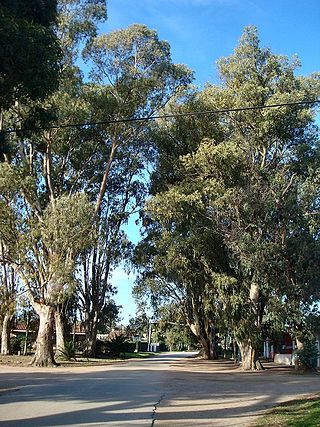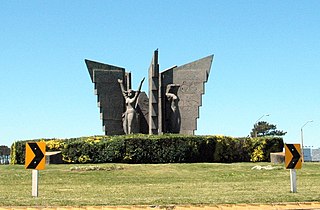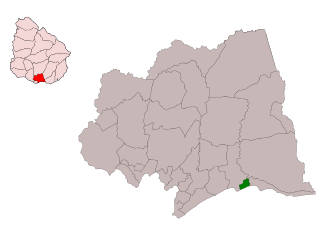The Departamento de Canelones is one of the 19 Uruguayan departments. With an area of 4,536 km2 (1,751 sq mi) and 518,154 inhabitants, it is located in the south of Uruguay. Its capital is Canelones. Ciudad de la Costa is the largest city by total population and Las Piedras is the largest city with an official census.
Rivera Department is a department of the northern region of Uruguay. It has an area of 9,370 km2 (3,620 sq mi) and a population of 103,493. Its capital is the city of Rivera. It borders Brazil to the north and east, Cerro Largo Department to the southeast, Tacuarembó Department to the south and west and Salto Department to the northwest.

Shangrilá is a coastal resort or residential neighbourhood of the Ciudad de la Costa in the Canelones Department of Uruguay.

Ciudad de la Costa is a city in Canelones Department of Uruguay, on the banks of the Río de la Plata between the streams Arroyo Carrasco and Arroyo Pando. It is considered an extension of the metropolitan area of Montevideo which it borders to the west, while to the east it borders Costa de Oro. It was declared a city on 19 October 1994 and given its current name. At the 2011 census, it was the second most populated city of Uruguay between Montevideo and Salto.

Atlántida is a resort town of the Costa de Oro in Canelones Department of Uruguay, 45 kilometres (28 mi) east of Montevideo. It is located on Ruta Interbalnearia, near the junction with Route 11.
Progreso is a city in the Canelones Department of southern Uruguay.
Costa de Oro is a 45 kilometres (28 mi) long group of resort towns and beaches in Canelones Department, Uruguay, east of the Ciudad de la Costa. Until 19 October 1994 it also included all the resorts that became henceforth integrated under the name Ciudad de la Costa. Since then, Costa de Oro contains only the resorts and locations of the area delimited by the streams Arroyo Pando to the west and Arroyo Solís Grande to the east and by the highways Ruta 8 and Ruta 9 to the north.
Costa Azul is a village and resort of the Costa de Oro in the Canelones Department of southern Uruguay.
Dr. Francisco Soca or Soca is a small city in the Canelones Department of southern Uruguay.
Las Toscas is a resort of the Costa de Oro in the Canelones Department of southern Uruguay.

Montes is a village in the east of Canelones Department of southern Uruguay.

Parque del Plata is a city of the Costa de Oro in the Canelones Department of southern Uruguay.

Salinas is a city and resort of the Costa de Oro in the Canelones Department of southern Uruguay.

San Luis is a village and resort of Costa de Oro in the Canelones Department of southern Uruguay.
Sauce is a small city and municipality in the Canelones Department of southern Uruguay.

Estación La Floresta is a suburb of La Floresta in the Canelones Department of Uruguay.

Ruta Interbalnearia or Ruta Líber Seregni is a national route of Uruguay. It connects Montevideo with Punta del Este to the east along the coast. The road is approximately 90 kilometres (56 mi) in length. It is marked on maps and signs as IB.
Paso de Carrasco or Paso Carrasco is a city in the Canelones Department of Uruguay.
Las Vegas is a tiny resort of the Costa de Oro in the Canelones Department of southern Uruguay.

The municipality of La Floresta is one of the municipalities of Canelones Department, Uruguay, established on 15 March 2010. Its seat is the city of La Floresta.
















